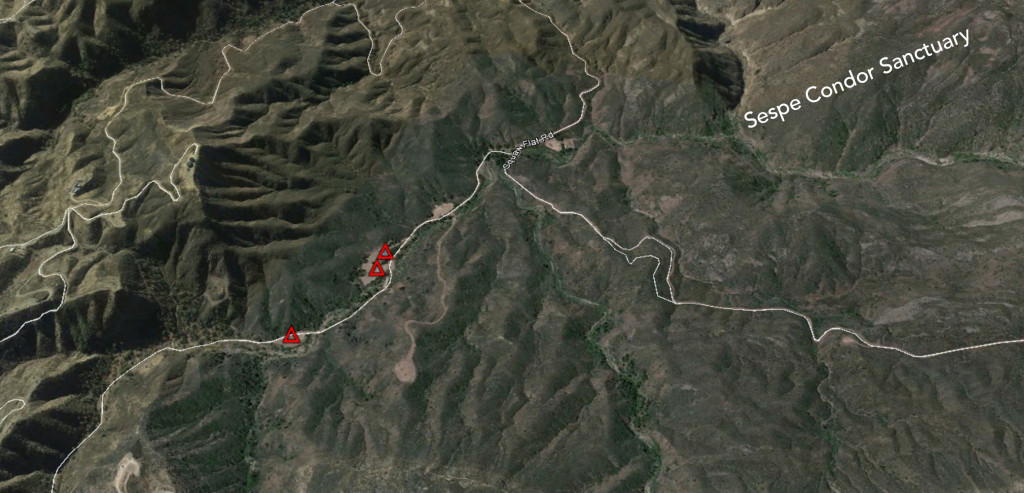County & State Agencies Erroneously Issued Permits for Drilling on Private Land in Los Padres National Forest
This week, two regulatory agencies cancelled permits for three oil wells in the Sespe Oil Field after receiving complaints that the approvals were issued erroneously, and without any public notice, hearing, or environmental review.
The permits – issued by the County of Ventura Planning Division and the California Division of Oil, Gas & Geothermal Resources – authorized Texas-based oil company Seneca Resources Corporation to deepen three existing oil wells along a tributary of Sespe Creek, just one-half mile from the boundary of the Sespe Condor Sanctuary. Operations like this in the Sespe Oil Field have increasingly relied on hydraulic fracturing, the controversial oil extraction technique involving pumping sand, water, and thousands of gallons of chemicals underground to stimulate oil production.
The permits were issued the same week that the U.S. Forest Service announced a proposal to hydraulically fracture eight additional wells on national forest land in the same area. Fracking has been approved or proposed for a total of 29 wells in the Sespe Oil Field since 2011.
“Fracking is making an alarming resurgence in the Sespe watershed, one of the most ecologically sensitive areas in Ventura County,” said Jeff Kuyper, executive director of Los Padres ForestWatch, a watchdog organization that monitors oil drilling in the Los Padres National Forest. “No fracking should occur here until regulations are finalized and until environmental studies on the impacts of fracking are completed.”

The drilling was initially approved by the Planning Division as an “over-the-counter” Zoning Clearance on May 5, 2014. Zoning clearances are issued by planning staff for minor projects that have already been approved under a Conditional Use Permit (CUP). The County issued a CUP for these oil wells in 1976, and significantly updated that permit in 1981.
However, when the oil company applied for Zoning Clearances for the three wells in April, the company erroneously claimed that the 1976 permit was in force. County planners did not verify that this permit had been superseded by the 1981 permit, and approved the Zoning Clearances 12 days later without any public notice, hearing, or environmental review.
The 1981 permit does not allow the County to issue Zoning Clearances for “deepening” wells. Instead, it states that “redrilling (deepening, reworking, or kicking-out) of a completed well previously approved shall require the filing of a Minor Modification application for approval by the Planning Director.” This involves a more detailed approval process that can only be completed after a public hearing and the preparation of environmental documents.
On Monday, May 12, ForestWatch notified the County and DOGGR about the error. ForestWatch also announced its intent to file an appeal with the County Planning Commission. On May 14, DOGGR cancelled the permits, and the following day, the Planning Division notified the oil company that the approvals were nullified.
“This letter is to notify Seneca Resources Corporation that the County Planning Division has determined that the Zoning Clearance issued to Seneca Resources Corporation on May 5, 2014 (ZC14-0448) was issued based on invalid information and is therefore nullified,” states a letter from the County to Seneca dated May 15, 2014.
According to the cancellation letter, the oil company will need to re-apply for a Minor Modification. A permit modification requires a public hearing and environmental review under the California Environmental Quality Act.
“We’re pleased that the County and DOGGR realized this error and promptly cancelled the permits that were erroneously issued,” said Kuyper. “Under no circumstances should fracking and oil drilling be fast-tracked in the Los Padres National Forest.”
Hydraulic fracturing – commonly known as “fracking” – is a process whereby water, sand, and thousands of gallons of chemical additives are injected underground to break apart rock formations and stimulate the extraction of oil and gas. The technique has come under increasing scrutiny from scientists, regulators, and the public due to concerns with groundwater contamination, surface water pollution, water consumption, and public health. Hundreds of fracking chemicals are known to be toxic to humans and wildlife, and several are known to cause cancer.
The three wells were initially approved and drilled in the late 1970s. According to DOGGR well records, all three wells were fracked at that time, and their production has declined ever since.
Located approximately four miles north of Fillmore in Ventura County, the Sespe Oil Field is one of the oldest oil fields in California. Approximately half of the field’s oil and gas wells are located on land in Los Padres National Forest. The other half are found throughout a patchwork of private land that is intermingled with the national forest land.
The lands in and around the oil field provide important habitat for endangered California condors, including the Sespe Condor Sanctuary, the Hopper Mountain National Wildlife Refuge, and the Sespe Wilderness. The headwaters of several mountain streams originate in the Sespe Oil Field before emptying into Sespe Creek, which is formally-designated critical habitat for endangered southern steelhead and is classified as an “Area of High Ecological Significance” by the U.S. Forest Service.
The Los Padres National Forest is the only forest in California with oil drilling and fracking taking place within its boundaries. Oil wells in the Sespe Oil Field have been fracked 18 times in the last three years, without any public notice or environmental studies and with minimal regulatory oversight. More fracking occurs in the Sespe Oil Field than anywhere else along California’s central coast between San Francisco and Los Angeles.







Comments are closed.